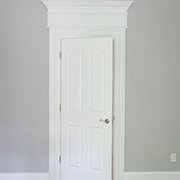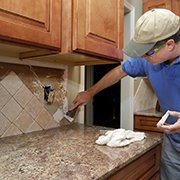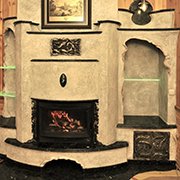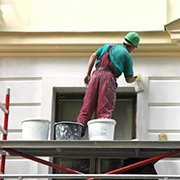Base trim
The basement, or the lower part of the outer wall of the house, can be part of the strip foundation, which protrudes above ground level. Or an independent element over another type of foundation. The most difficult to provide protection from atmospheric precipitation and mechanical damage is the base, located flush with the wall. Therefore, part of the wall at the foot of private houses, as a rule, sinks inward or protrudes outward by several centimeters. In the first case, the basement is covered by a wall, in the second case plums are constructed.
Correct cladding not only harmonizes with the facades, but also helps the plinth to perform its main function - to protect the house from moisture from the outside and to remove steam outside. This article contains a video about the features of finishing the basement with sandstone, decorative plaster, tiles, natural stone, facing bricks and the construction of basement siding.
The content of the article
Sandstone basement
Sandstone is more affordable and cheaper than other natural stones, moisture resistant, lightweight. In addition, the layered structure of the material provides heat conservation. Therefore, this method of decoration is still popular, despite the new fashion trends. If you plan to sandstone the basement yourself, the video will help you deal with possible difficulties. However, it is necessary to take into account the shortcomings of the sand stone in comparison with other stones for decoration, for example, marble or granite. In strength and durability, sandstone, unfortunately, loses.
But in the case of the basement of the house, which is not planned for chemical and climatic overload, sandstone is a reasonable option in terms of price and quality. To improve the result, another layer of insulation is placed between the wall and the decorative coating. It is glued to the body or put on a dowel-nails.
Finishing the base with decorative plaster
Decorative plaster is the second easiest way to clad the basement of a house after a painted cement-sand coating. The material compares favorably with the presence of polymer components in the composition, providing a longer service life and effective protection against moisture.
Covering the plinth with decorative plaster will cost more, but it will be stronger and show higher adhesion. This means that regardless of the choice of silicone, silicate or mineral plaster, it is easier to fix such a cladding to the wall. A little secret that not all home masters know about - after drying, the coating is treated with a three percent solution of hydrochloric acid.
Tiling of the plinth
The tiles used for the exterior decoration of the house are partially presented with requirements similar to those on the inside - so as not to absorb moisture, withstand occasional shocks and fit the design. Base trim tiled, the video of which can be seen below, will justify the investment if the material does not burn out from exposure to ultraviolet radiation and is not damaged by contact with chemicals such as those used on roads in winter. Of course, the last factor affects the choice only if the house is close to the roadway.
Watching a video about tiling the basement will not hurt to familiarize yourself with the sequence of work. But the calculation of the coating that you need, ask to do when buying, after measuring the surface area. Also, the seller will ask about the linear length of the slopes and angles.The amount of glue and grout are calculated independently, also based on the square of the cladding.
Facing the base with natural stone
Video about basement trim under the stone with your own hands - a popular request from users who have already decided on the appearance of the future facade of the house. The stones for the lower part of the wall are taken, as a rule, dark, since dirt and dust settle here.
Studying the market of hard facing stone, we note that the less well-known siltstone and quartzite, not inferior in density, compete with the leading granite.
Natural stone, as shown in the video, will be dolomite, sandstone, and limestone, which is less solid, but suitable for long-term facing of the basement. It is cheaper and easier to work with due to its lower weight. However, additional costs will require care products. Since the porosity of such stones is higher, it is recommended to treat them with water-repellent impregnations.
If you find it difficult to independently sandstone the basement, the video will help you master the technology.
Marble is also chosen for finishing facades, but in a humid climate, restoration of such a coating will be needed very soon. Given the considerable initial cost of the material, marble cladding seems to be an unprofitable solution.
Installation of basement siding
The second name of the siding is facade panels made of synthetic raw materials (plastic or vinyl). Buyers are wary of artificial lining, mistakenly believing that this is a less reliable solution than natural materials. But high-quality vinyl panels are durable, do not suffer from temperature changes, do not absorb moisture, are inexpensive. In addition, if you look at the installation instructions for the basement siding by video - work will go easier.
From an aesthetic point of view, the panels are favorably distinguished by a wide range of textures and colors (here, natural stone, brick, and other popular options), as well as ease of maintenance. Sheathing surfaces do not require preparation, except for the elimination of protruding sharp elements. If the listed advantages are convincing, it's time to watch a video about installing the basement siding with your own hands and get down to business!
About the basement finish
A minimum base height of 0.2 meters is rare, more often this element is made half a meter or higher. Therefore, mastery of performance significantly affects the comfort of being in a building. And the appearance is the first impression that the house makes on the guest. Moreover, the coverage square in both cases is small, few materials are required, and for this reason, you can refuse to save in favor of buying a respectable coating produced by a reputable manufacturer.
Explore the market in advance, before going to the hardware store or ordering online. Consulting sellers will also help you navigate the variety of options. Watch a video demonstrating the finish of the base in various ways to decide whether you can handle this task yourself, or whether it’s easier to attract specialists.
Finishing the base with facing bricks
The reason to use bricks, rather than imitate masonry using clinker tiles - an additional space between the wall and the lining for laying the insulation layer. In addition, the use of bricks with internal cavities contributes to the improvement of thermal insulation properties, since the air gap retains heat.
The nuance is that for brickwork you will need your own strip foundation, therefore, it is advised to plan such decoration even at the stage of building construction. Watch the video about finishing the basement with a brick to find out about the other features of the work.
Conclusion
The choice of material for facing the basement depends on the budget, the preferences of the owners and the features of the structure.Siding is chosen for cladding frame buildings, structures made of concrete and brick are often trimmed with stone, plaster and tile. The facade looks contrasting, rather than merging with the base.
But in construction, aesthetics still follow practicality. Therefore, you have to choose the method of exterior decoration, guided primarily by the characteristics of the house, location and environmental factors. Then updating the facades will not soon be at the top of the task list.





